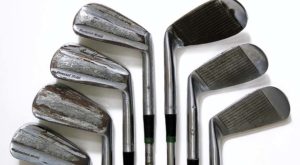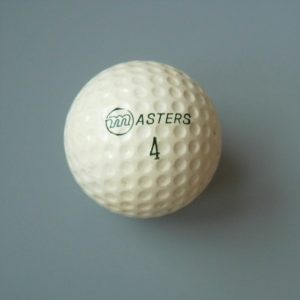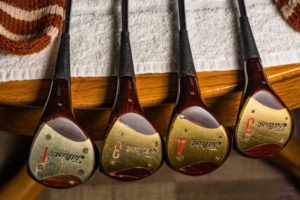
One of my dad’s spare time passions, and, by extension, one of mine, was golf.
His preferred course was the Miami Country Club (not a member, BTW). It was a nine hole layout that I never played. However, I did earn many a quarter (worth approximately $200 in kid bucks of the 60’s) for dutifully pulling his clubs around and staying (mostly) quiet.
I was too short to effectively take a real swing. However, he did allow me to take putts when there was nobody behind us to get irritated at a kid messing around on the green ahead of them.
Dad had an Acushnet Bull’s Eye putter, a classic design that is still manufactured and still popular. He also had a McGregor Tommy Armour Ironmaster, nowadays a valued collectible which I am proud to still own.
He was a bogey golfer who once shot a nine hole round at even par. What makes that feat all the more remarkable is that he did it with 60’s vintage equipment.
Golf equipment evolution had remained pretty stagnant since the quantum leap of replacing the old torque-plagued hickory shafts of the Bobby Jones era with steel versions that didn’t force you to close the club face at setup in order to achieve squareness at impact.
By the time our fathers went to war, the golf clubs they left in their garages back home had the newfangled steel shafts.

So when dad headed for Baxter Springs, KS to play the course there (another favorite haunt of his), he took along his trusty state-of-the-art Wilson Staff blades and laminated woods. He also had a bunch of Titleists in the bag, which set him back about a dollar apiece at the pro shop.
I would head for the rough and pick up lost golf balls at every opportunity. Dad would pay me a dime apiece for mint-condition examples of top-end brands like Spalding Dots, MaxFlis, or Tourneys. And a primo still-shiny Titleist might fetch as much as a quarter! That bought a lot of candy.
However, most of the orphaned balls I located had big “smiles” on them. Those were nasty cuts that were caused by “cold-topping”, i.e. swinging too high and striking the ball with the sharp lower edge of the iron.
Those laminated woods would make the ball fly, but they had the same basic flaw as did the blade irons: a sweet spot approximately half the size of a gnat’s wazoo.
Dad had sprung for a Kenneth Smith customized driver made of a block of pure persimmon. That was the same material that Arnold Palmer used in his woods. Of course, Arnie could also afford his own jet.

The persimmon was inherently harder than the cheaper laminated wood, and theoretically made the ball fly farther. It definitely had a different feel that was worth the extra bucks, in the opinion of 60’s golfers.
Dad had a pretty pure swing for a weekend golfer. He played a natural draw, an accomplishment in itself. When he connected, he could send the ball out as far as 240 yards.
Nowadays, we Boomers play with cavity backed irons that allow badly mis-hit shots to still travel a respectable distance and fly pretty straight. We swing feather-light metallic woods the size of travel trailers that routinely allow us to pop cut-proof balls with scientifically-enhanced spin 270 yards with ease. Steel shafts? How passe. We use graphite models that have various inherent properties that cause them to flex exactly the right amount at exactly the proper locations to cause the ball to fly as far and as straight as possible.
If you’re lucky enough to still be able to enjoy a round of golf with your old man, ask him if he misses the equipment he played with back when LBJ was in the White House.